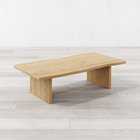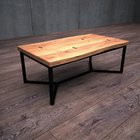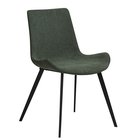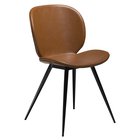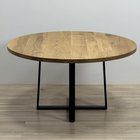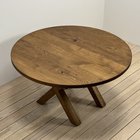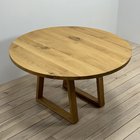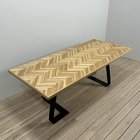Oak remains a beloved furniture wood cherished for its durable finish and elegantly grained look. But like all natural materials, it requires attentive cleaning and care for upkeep – especially if oak stained.
Review essential techniques for polishing wooden surfaces while targeting stubborn stains and drink rings before they become permanent scars on prized possessions.
Understanding Oak Furniture
Oak is a hard, dense wood, often chosen for its distinctive grain pattern and durability. It's typically finished with a stain or a clear protective coat, which calls for careful cleaning methods. Learning how to clean an oak table effectively can significantly enhance its longevity and appearance, requiring a combination of regular dusting, mild cleaning solutions, and immediate attention to spills.
Cleaning Oak Pieces
Regular cleaning is crucial to maintain the luster and longevity of stain oak furniture.
Routine Cleaning
Start with gentle dusting using a soft, dry cloth. For a deeper clean, lightly dampen a cloth with water and gently wipe the surface. Always follow up with a dry cloth to remove any moisture. Avoid using excessive water as it can damage the wood.
Deep Cleaning
For more stubborn dirt, a mild soap solution can be effective. Mix a small amount of dish soap with water, dampen a soft cloth in the solution, and wring it thoroughly before gently wiping the wooden surface. Rinse the area with a clean, damp cloth to remove any soap residue and dry the surface immediately.
Removing Stains
Stains on oak can be challenging, but they are often treatable with the right approach. Mastering how to remove stains from wood is crucial for preserving the natural beauty and integrity of your wooden furniture, involving gentle techniques and specialized products to restore its original luster.
Water Stains
For fresh stains, use a dry cloth to absorb moisture. If white rings form, a small amount of non-gel toothpaste can be gently rubbed on the stain with a soft cloth, followed by a wipe-down with a damp cloth and thorough drying.
Dark Stains
Dark stains require light sanding along the grain with fine-grit sandpaper. If sanding doesn't work, a small amount of bleach, tested on an inconspicuous area first, can be applied. After the stain lightens, neutralize the bleach with vinegar and water solution, then rinse and dry the area.
Cleaning Sticky Residue from Oak Furniture
Spilled soda, gum, stickers or tape can leave a stubborn sticky residue on surfaces.
- Use a plastic scraper to lift the residue
- Apply a mixture of equal parts vinegar and water
- Let the solution sit for 5 minutes
- Wipe with a clean damp cloth
- Dry with towel
Removing Ink, Marker and Crayon
Permanent ink and markers, as well as wax crayons, can leave pesky stains. Thankfully, the oil in the wood makes it possible to lift these stains.
- Apply a small amount of toothpaste to the stained area
- Gently rub with an old toothbrush
- Wipe away toothpaste
- Rinse cleaner residue
- Dry thoroughly
- Use nail polish remover only if needed for final residue
Restoring Oak Furniture
Over time, wooden pieces might lose their shine or accumulate minor scratches.
Refinishing the Surface
Clean the surface, then sand it with fine-grit sandpaper to remove the old finish. After dusting off the residue with a tack cloth, apply an oak-stain finish, following the grain. Once the stain dries, apply a clear finish to protect the wood.
Minor Scratch Repair
Use a stain marker that matches your furniture's color to gently cover scratches, blend into the surrounding area, and wipe away any excess.
Oil Treatment to Restore & Protect Oak Furniture
Over time, hardwood furnishings can start to look dull and dry. Using an oil treatment brings back a beautiful rich color and protects the wood grain.
- Clean thoroughly before oiling
- Apply a thin coat of mineral oil, tung oil or Danish oil with a soft cloth
- Rub into grain to condition wood
- Remove excess oil
- Let dry for 24 hours
- Apply wax paste to finish
How to Handle Severe Stains and Damage
Addressing severe stains and damage on stained oak furniture demands specialized care.
For Burns or Deep Scratches
Gently sand the affected area with fine-grit sandpaper, working along the wood grain. Apply a matching wood stain, and finish with a sealant for protection. For burns, you may need to remove the charred wood before sanding.
Chemical Stains
If a harsh substance causes discoloration, sanding and refinishing might be necessary. Test a small, hidden area first to gauge the impact.
Seeking Professional Help
When damage extends beyond superficial fixes or if the piece is antique or valuable, it’s wise to consult a professional restorer. Complex issues like structural damage, intricate carvings, or historical preservation require expert skills and tools.
In dealing with severe damage, patience and a careful approach are key. Sometimes, professional intervention is the best course to restore the furniture's integrity and appearance.
Preventive Measures to Avoid Future Stains
Protecting oak furniture from future stains requires a combination of foresight and prompt action. Here are some effective preventive measures.
Use Protective Coverings
Invest in tablecloths, placemats, or coasters to shield the wood surface from spills and heat marks. These coverings act as a barrier against potential stains, particularly during meals or when serving hot beverages.
Apply Sealants
Regularly apply a sealant like wax or a specialized wood protectant. This not only enhances the wood's natural beauty but also forms a protective layer that repels liquids, reducing the risk of stains seeping into the grain.
Avoid Direct Sunlight
Prolonged exposure to sunlight can fade and weaken the finish, making the wood more susceptible to damage. Position oak furniture away from direct sunlight or use curtains to filter intense rays.
Immediate Response to Spills
In the event of a spill, act quickly. Blot the liquid immediately with a soft, absorbent cloth. Avoid wiping as this can spread the stain. For sticky substances, gently scrape off the excess before cleaning.
Regular Dusting
Frequent dusting prevents the buildup of grime and dust, which can become ingrained and lead to staining over time.
Closing Thoughts
With proper regular care for dusting and gentle surface cleaning along with these handy tips for treating common stains, you can restore oak furniture. Avoid harsh chemicals or abrasives that could degrade the finish. A little bit of elbow grease with gentle cleaners like dish soap, vinegar, toothpaste and oil goes a long way in removing stains from hardwood items.
Be patient, let solutions sit when needed and make sure to thoroughly dry wood surfaces after cleaning. Follow up with an application of oil or wax to condition and protect the timber grain’s finish. In no time, your furniture can look revived and ready to enjoy for years to come.








